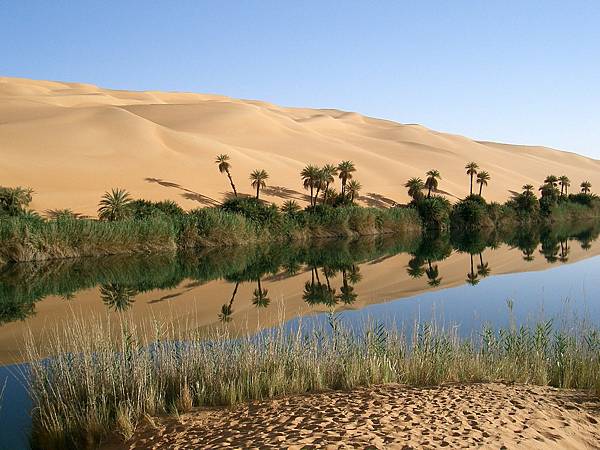
As I said in the last post, oases are magical sorts of places, with their existence being so seemingly impossible. But this leads naturally to the question: ‘Why are they possible?’, or more specifically, ‘Where does that water come from?’ Well, it doesn’t come from the sky – at least, not directly. It comes from the ground. Here is the relevant passage from my book – but this is quite a technical passage, giving some science, so there are many difficult words.
But where did that water come from, given that for hundred of kilometres around me, rain seldom fell? The answer to that lies in the fact that the ground under our feet is essentially in layers, or strata, each of a different type, with different composition and physical properties. Take a look at pictures of the Grand Canyon in America, and this will be very clear indeed. Porosity is the key factor here. Some rock layers contain pore spaces, and when the spaces are connected, even microscopically, water is able to seep very slowly through the matrix. In other words, it is permeable. This is particularly true of sandstone, which, when exposed to rain, say on a mountain side, can absorb some of this water. If this porous layer has non-porous impermeable layers above and below, then the only way is down through that layer to wherever it leads.
Although those Grand Canyon pictures show an almost perfect horizontality in the layering, that is only because that specific landform is part of a geologically stable high plain, a long way from the complicated buckling and folding caused by the action of plate tectonics in mountainous or coastal regions. With such action at work, an imaginary cross-section of the ground beneath one’s feet would take on a shattered glass appearance, meaning that the water can migrate along an interesting path indeed. This can be long, very long, going through hundreds of kilometres of subterranean strata to spill out at lower elevations where the water-bearing layers are exposed at the surface. With the collective weight of the water at higher elevations over the stretch of strata, the pressure can build up enough to have the water gush, in which case it creates a ‘flowing artesian aquifer’, which was exactly what I was looking at. The actual intake area for the aquifer before me could have been more than 800 kilometres away, and I could only guess where that was. Perhaps the low hills of the Saharan Atlas near the northern coast, or the higher Tell Atlas in Morocco.
Maybe everyone should click on aisielts.com, then About AIS then My Philosophy. You will see that this philosophy is all about learning - and the above passage is an example. I saw an 'artesian aquifer', and I immediately wanted to know how it happened. And I found out. And it's in my book. And now it's on my pixnet for you to read.
My advice to all IELTS students is to get your noses out of bad IELTS bads from Taiwan and China. My advice to be begin learning about this amazing world, and don't stop doing this. That's how people become better speakers, readers, writers, and listeners. Think about this, and think also about all the difficult words in the above passage. You'll have to find out what they mean, right?
Find the meaning of the underlined words, also repeated below.
- essentially (adv)
- strata (n)
- pore // porous (n//adj)
- to seep (v)
- (im)permeable (adj)
- to buckle (v)
- to shatter (v)
- subterranean (adj)
- elevation (n)



 留言列表
留言列表


